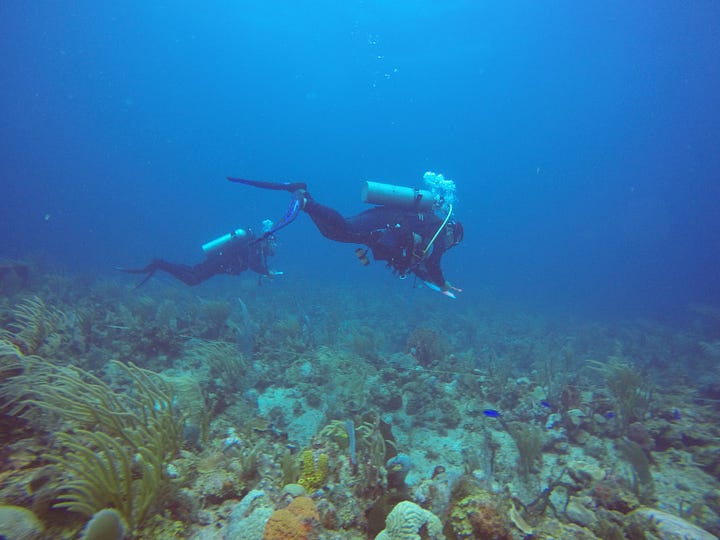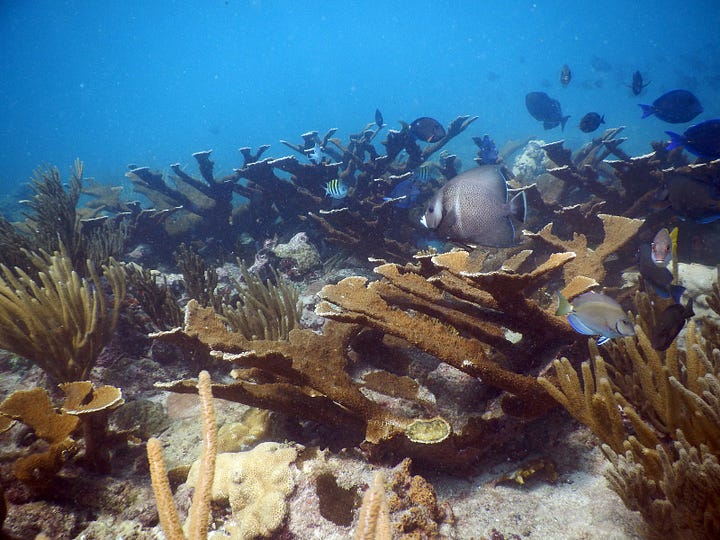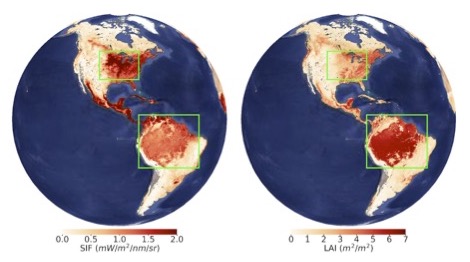For decades, scientists have used satellite data to assess the health and greenness of Earth’s…
In Conversation, Scientists at BAERI: Dr. Juan Torres-Perez
Dr. Juan Torres-Perez is a coral reef biologist working for BAERI at NASA Ames Research Center. Originally from Puerto Rico, he works at the intersection of coral reef biology, remote sensing, education, and citizen science. “I have five proposals out right now,” he says with a laugh, and an energy that is palpable and contagious even over video conference. This interview has been edited for length and clarity.
Erin Bregman: How would you like to introduce yourself?
Juan Torres-Perez: I’m Juan Torres-Perez, a research scientist with the Bay Area Environmental Research Institute (BAERI) and I’ve been with BAERI since 2013. I’m a coral reef biologist, and so most of my work is related to remote sensing. I’m studying coastal ecosystems, shallow water marine ecosystems in particular.
EB: What do you wish more people understood about corals?
JTP: A lot of people look at corals and think, ‘Oh, those are pretty rocks.’ No, they’re not really rocks. They’re animals, they just don’t move. They stay in one place their whole life, and are the main builders of the ecosystems that we know as coral reefs. And these ecosystems have a huge impact on literally millions of people around the world — not only in economic terms, but also recreationally and, probably even more importantly, on coastal protection. I mean, there are a lot of places in the world where if there are no coral reefs, you won’t have the islands. You know, that simple.
EB: Where did your own interest in coral reefs begin?
JTP: I got interested in the ocean. The very first time I was able to put on a diving mask, I was probably eight years old. At that time, in Puerto Rico, my grandpa and my father used to take me to the beach almost every weekend. And the first time I saw mostly sand, because I was on a beach. But I also saw some fishes and other organisms that I got really interested in. And that’s how my interest started. Now, I’ve been a scuba diver for twenty nine years. I’ve been on more than 2,000 dives in those twenty nine years and more than 90% of them have been related to scientific diving. There haven’t been two dives that are completely the same. There’s always something different to see out there.
EB: Do you remember your first dive at a coral reef?

Flower Coral, Puerto Rico; Image: Juan Torres-Perez
JTP: That was back when I was doing my bachelor’s degree at the University of Puerto Rico in Biology. I wanted to do a research project, so I contacted this professor at the university who was the expert in coral reefs in Puerto Rico. His name was Carlos Gonzaga, also originally from Puerto Rico, and he accepted me as a student in his lab. He took me to one of his study sites on the west coast of Puerto Rico. And I remember, during that first dive, he was pointing out the different species and telling me, ‘This is that!’ and ‘There’s this other one.’ Some of the invertebrates I had not seen before. It was, I mean, to me it was obviously an eye opener.
EB: What is it like to see a bleached coral reef?
JTP: It’s really shocking. You’re always used to seeing corals in their whole beauty, with all the colors and everything, and then all of a sudden it’s just white. When you see corals that are bleached, it doesn’t necessarily mean that they’re dead. I would say probably 99% of the colors of the corals is because of their symbiotic relationship with microscopic algae that live inside their tissues. And that microscopic algae is photosynthetic — it has chlorophyll, some carotenoids and other pigments, and that is what gives the corals their color. And what happens with bleaching, which could be caused by sea surface temperature, or sedimentation, or UV radiation, what happens is that either the zooxanthellae, which is the name of these microscopic algae, either they lose their pigments or they are expelled by the corals, or maybe a combination of both. So what you’re seeing is pretty much the transparent tissue of the corals, and the skeleton beneath the tissue.
EB: What’s the main focus of your work?
JTP: Most of my projects are related to: What are the effects of different anthropogenic (human) impacts on coral reefs? Most of my projects in Puerto Rico, for example, have been related to changes in land use, changes in land cover, and changes in the watershed and how that translates to an increase in sediments in the river, and eventually in the water column that surrounds the corals.
EB: From what I’ve read about your projects it seems like education and citizen science play a major role in how you work.
JTP: Before coming to Ames, I was a professor at the University of Puerto Rico for four years in the biology department. My life has always been related to education in some way. I’ve always been interested in not only education, but also in citizen science. Two years ago I was a PI of a project in Puerto Rico. It was a citizen science project. The idea was to train divers, just regular divers, particularly dive instructors, to collect field data that we could use for image validation and scientific characterization of coral reefs. We trained a number of dive instructors, and then they would go into the field, to their particular sites where they would usually just bring people to do recreational diving, and they would use part of that time to collect data for us. And then we would use that data for characterization.

CoralBASICS dive instructors collecting data; Image: Juan Torres-Perez
Coral reefs don’t change that much unless a big event happens. What we told them was, ‘If you can just collect the data every two months or so, that’ll be more than enough for us.’ And the typical answer from them would be, ‘Why do we need to wait two months? Can we just go next month or something?’ It was fun. It was fun for them. They learned quite a lot. And it also gave us the opportunity to relate back to the community as well. You know, these people were born there. They were raised there. And they know the sites like the palm of their hand. They sometimes go there during the morning, during the afternoon and then during the night. So why not train them and get some help from them collecting the data? Because in my case, I can only go once or twice a year.
EB: And I would imagine they would be the first people to notice if something changed?
JTP: Exactly. Exactly. They can tell you. They can pinpoint to the — I don’t know — to the centimeter scale. They can bring you there and show you exactly what happened.
EB: How did you share the results of that project?

CoralBASICS project underwater team; Image: Juan Torres-Perez
JTP: We decided not to publish in a peer reviewed journal, actually. NOAA, The National Oceanic and Atmospheric Administration, has the Sea Grant Program. They have an office in Puerto Rico and produce educational materials that are made available to the general public. We are actually in the process of publishing a report in one of their magazines, which is distributed to the schools, the dive shops, and to pretty much anyone on the island. In the end, my co PIs and I, who are also from the University of Puerto Rico, we decided, what’s the purpose of making a peer reviewed publication if it’s not going to be available for the general public, for the people who actually did the project for us?
EB: NeMO-Net, another project you’ve been working on, is all about citizen science and education. Congratulations! It looks like it’s been a very successful project.
JTP: Thanks! We’ve had almost forty six thousand downloads of the app. And the Android version is still in beta. So far it’s only either iPads or iPhones. So we’re definitely expecting it to increase exponentially. The cool thing about NeMO-Net is that anyone can use it. To me, it’s an almost perfect educational tool because, I mean, my seven year old uses it and enjoys it because you’re pretty much painting on top of an iPad.
I think we’ve had about 70,000 different benthic characterizations so far. With NeMO-Net, you start out just classifying, say, coral versus non coral. And once you become more and more expert, more different classes get added for you to add to the classifications, until it gets to the family level, in terms of corals in particular, which is a pretty high taxonomic level.
EB: I was also just reading about the coastal ecosystems remote sensing training you did. A lot of people attended! Are those training sessions always so popular?
JTP: I’ve been with ARSET (NASA’s Applied Remote Sensing Training Program) since the summer of last year, and this is actually the first coastal related training that I’ve done with them. I’ve been involved in a number of other training sessions, particularly related to sustainable development goals from the United Nations, but with this one I was pretty much the person in charge of running the whole thing because it’s my area of expertise. And it was bilingual, which was part of what made it so successful.
Because Spanish is my first language, whenever I’m in charge, or at least part of one of these trainings, we try as much as possible to make it bilingual. Usually what we do is have an English session in the morning, and a Spanish session in the afternoon. It opens the opportunity to even more participants. For the coastal one, which ran for three weeks once a week, we had, in total, almost three thousand participants from about one hundred and fourteen different countries around the world.
I believe it was the first ARSET Webinar ever given for coastal ecosystems in particular. I mean, there have been a number of ARSET Webinars related to water quality, algal blooms and things like that, but this was the first one specifically for shallow water, coastal ecosystems. We made it an introductory webinar. So it would be, you know, just general topics. We’re planning a second part, a more intermediate one, for the next year.

Elkhorn coral community, Puerto Rico; Image: Juan Torres-Perez
EB: One more question: What does science mean to you?
JTP: I would say science is a way of finding — of finding how a physical environment works and how everything in life is connected, one thing with another. In my classes, I always tell students not to look at it only from the biological point of view or from the chemical point of view. Everything is connected. That’s why and how we have science. That’s why we have the scientific method. I tell my students: You don’t think about it, but you use the scientific method every single day of your life. You just don’t know. When you’re making a decision, you’re making a hypothesis about whether this is good or bad, and then you make a decision about it. And to make the decision, you have to go through a series of observations and then eventually come up with some sort of idea. So science is the way that we find out about things, about how things work.
Since publishing this article, Juan has transitioned to a civil servant position in the Biospheric Science Branch in the Earth Science Division at NASA Ames.


